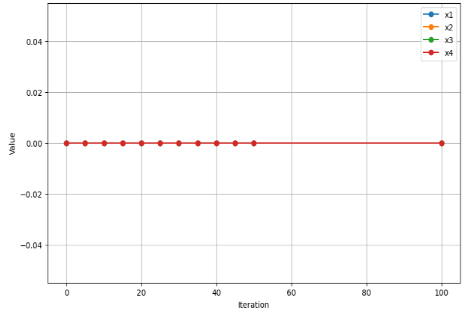COMPARATIVE ANALYSIS OF GAUSS SEIDEL, CONJUGATE GRADIENT AND SUCCESSIVEOVER RELAXATION FOR THE SOLUTION OF NONSYMETRIC LINEAR EQUATIONS
DOI:
https://doi.org/10.62050/fjst2025.v9n1.349Keywords:
Conjugate Gradient, Nonsymmetric linear systems, Successive Over-Relaxation, Gauss-Seidel, ComputationAbstract
This study undertakes a comparative analysis of three widely used computational methods namely; Gauss-Seidel, Conjugate Gradient, and Successive Over-Relaxation (SOR) for solving nonsymmetric linear equations. The main goal is to assess the effectiveness, efficiency and convergence rates of these methods when applied to nonsymmetric linear systems, which frequently occurs in scientific and engineering problems. The Gauss-Seidel method, known
for its iterative simplicity and straightforward implementation, is compared with the Conjugate Gradient method, which is acclaimed for its robustness and efficiency in handling large and sparse systems. The SOR method, an optimized version of Gauss-Seidel, was also evaluated to determine its potentials for accelerating convergence. Through a series of numerical experiments and performance benchmarks, the study reveals that the Conjugate
Gradient method consistently outperforms the other two methods in terms of convergence, speed and computational efficiency, particularly for large-scale nonsymmetric systems. The Gauss-Seidel and SOR methods, while showing competitive performance for smaller or less complex systems, do not match the efficiency of the Conjugate Gradient method in more demanding scenarios. Based on the results, the Conjugate Gradient method is recommended as the preferred choice for solving large nonsymmetric linear systems due to its superior performance.
Downloads
References
Bakari, A. I., Dahiru, I. A. (2018). Comparison of Jacobi and Gauss-Seidel Iterative Methods for the Solution of Systems of Linear Equations, Asian Research Journal of Mathematics, Volume 8, Issue 3, 2018, Pages 1-7.
Raj, D. (2017), Comparative Analysis Of Gauss Eliminationand Gauss-Jordan Elimination, IJARIIE-ISSN(O)-2395-439, Vol-3 Issue-1
Jatong, A. (2021). Comparative Analysis of some Iterative Techniques in the Solution of System of Linear Equations in Level Network. Journal of Applied Science and Management (JASM) Vol. 16 No. 1 (16-23)
Sidiki, M. (2015). Comparative assessment of iterative methods for solving systems of linear equations, Journal of Applied Mathematics, Volume 22, Issue 4, 2029, Pages 455-470.
Saha, M., & Chakravarty, J. (2020). Convergence of Generalized SOR, Jacobi and Gauss–Seidel Methods for Linear Systems. International Journal of Applied and Computational Mathematics, 6(3), 77. https://doi.org/10.1007/s40819-020-00830-5
Ibrahim, H. D., Chinwenyi, H. C., & Ude, H. N. (2021). On the algorithmic iterative solutions of conjugate gradient, Gauss-Seidel and Jacobi methods for solving systems of linear equations. World Academy of Science, Engineering and Technology, International Journal of Mathematical and Computational Sciences, 15(11), Article 800. Retrieved from https://www.waset.org/journal/Mathematical-and-Computational-Sciences
Wakili, A., Sadiq, M. (2019). Comparison of Quassi-Seidel, Jacobi, and Conjugate Gradient methods for convergence and speed using Matlab for linear systems of equations, IOSR Journal of Mathematics (IOSR-JM), Volume 15, Issue 3 Ser. III, 2019, Pages 38-44. https://doi.org/10.9790/5728-1503033844









